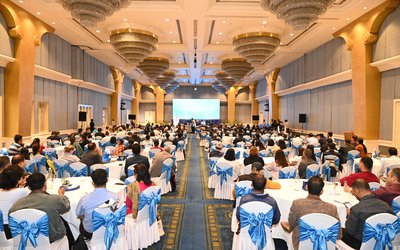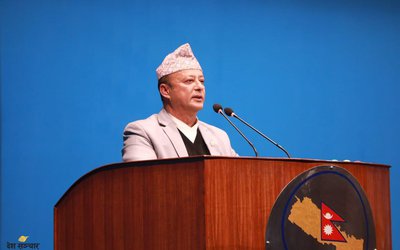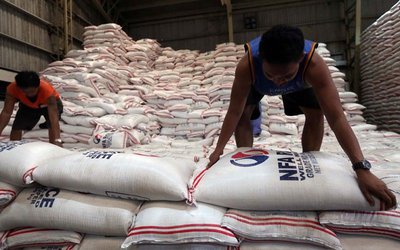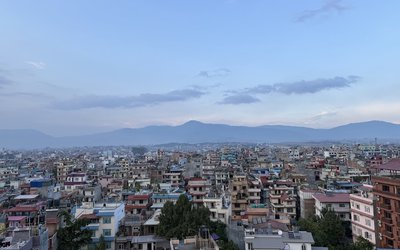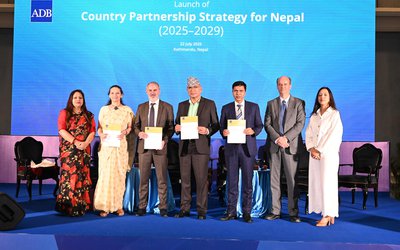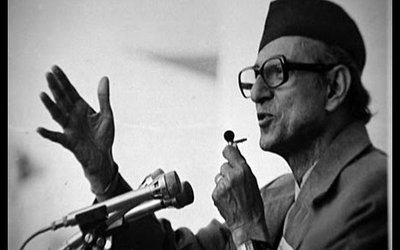KEY HIGHLIGHTS:
- DPs Support in Nepal: Historical Perspectives
- DPs in Nepal: Bilateral, Multilateral & Implementing Partners
- Slower Government Expenditure: A Bottleneck to Progress
- Status of ADB and WB-Supported Projects in Nepal
- Issues and Challenges for Slower Disbursement
- Actions and Systemic Interventions
- Path Forward
Abstract:
Development partner (DP) supports are instrumental in developing country’s economic development. Delays in government disbursements hinder the effectiveness of DP-supported projects in Nepal, mainly due to bureaucratic inefficiencies, weak institutional capacity, misaligned budgeting, and complex procurement processes. These systemic issues lead to underutilized resources, project delays, and reduced development outcomes. A review of ADB and WB-supported development projects highlighted various issues and challenges related to slower disbursement. To address these challenges, systemic interventions are essential, including streamlined processes, capacity-building, improved coordination, and alignment of budgeting with project timelines.
Key Words:Development Partners, Slow disbursement, Systemic interventions, Nepal
1 DPs Support in Nepal: Historical Perspectives
Foreign Development Partners (DPs) have long stood as supporting pillars of Nepal's economy. The country's long-standing relationship with its international development partners continues to play a pivotal role in driving the country’s economic and social development. Development partners have played a crucial role in supporting various sectors, including infrastructure, energy, education, health, and agriculture.
Nepal has long relied on international cooperation for the financing of key development projects. The country receives substantial funding from bilateral and multilateral agencies. These development partners offer both financial and technical assistance, supporting a range of sectors from energy to agriculture, with the aim of fostering sustainable growth and poverty reduction.Foreign assistance such received are incorporated into annual planning during the annual budgeting, where foreign grants and loans comprisea significant chunk of financing sources, in addition to taxes, non-tax revenues and borrowings.However, persistent issues with low government expenditure are limiting the full potential of this cooperation. The inability to utilize committed funds efficiently has sparked growing concern among stakeholders, casting a shadow over the progress that could have been made in critical sectors.
Nepal has been receiving foreign aid since the 1950s. The first significant influx of foreign aid came from the United States under the Point Four Program. This initiative focused on technical assistance and infrastructure development. With the launch of its First Five-Year Plan (1956-61), Nepal officially included itself among the aid-recipient countries for its development financing. In the following decades, Nepal received aid from various bilateral and multilateral donors, including India, the United States, the United Kingdom, and the World Bank. (WB)Aid was primarily directed towards infrastructure projects, agriculture, and education.The period after 1990 marks a significant increase in foreign aid to Nepal, driven by factors such as the country's political instability, economic challenges, and natural disasters.A wider range of donors, including European Union countries, Japan, and the Asian Development Bank (ADB), became involved in providing aid to Nepal, with the focus shifting from infrastructure to other pertinent issues such as poverty reduction, social development, and environmental conservation. Following the end of the decade-long Maoist insurgency in 2006, Nepal received substantial aid for reconstruction and development, which continued after the destructive earthquake of 2015 and the COVID-19 Pandemic in 2020.
In recent years, Nepal has committed to ambitious projects aimed at boosting its economy, improving living standards, and modernizing its infrastructure. Development partners have been instrumental in pushing forward Nepal's Sustainable Development Goals (SDGs) agenda, providing vital resources to address economic disparity and bolster climate resilience. For example, large-scale hydropower projects, road expansions, and rural electrification initiatives have benefited from external funding and expertise.
2 DPs in Nepal: Bilateral, Multilateral & Implementing Partners
As it is evident that Nepal has wholeheartedly embraced donor support for funding its development and social initiatives, there have been a steady number of countries and agencies who continue to channel funds into the country. According to the data maintained by the Ministry of Finance (MoF), the development partners have been categorized into three sections, namely Bilateral DPs, Multilateral DPs, and Implementing Partners. The list of DPs currently supporting the country are listed in the table below:
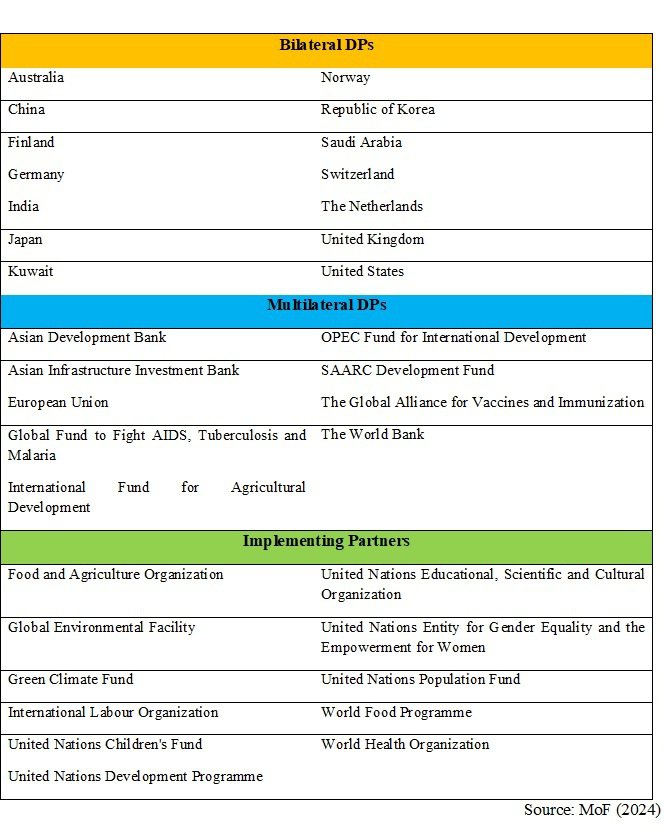
Bilateral DPs mainly consist of different ODA-providing countries, whereas multilateral DPs consist of several development banks and others working in multiple regions. MoF categorized implementing partners mainly for various UN agencies. The MoF has categorized the distribution of funds into 47 sectors, with the major sectors being health, energy, infrastructure, and local development.As of 15 July 2024, there have been 3515 donor-funded projects in Nepal, with total commitments of 35,451,478,896 USD.
3 Low Government Expenditure: A Bottleneck to Progress
Foreign aid has undoubtedly helped Nepal gather resources for much-needed development endeavors. However, its heavy reliance on foreign aid has raised concerns about aid effectiveness and governance.Despite the inflow of funds, Nepal has consistently struggled with low capital expenditure rates, particularly in development projects. According to the Ministry of Finance, the country has utilized only a fraction of the budget allocated to development initiatives each fiscal year. In FY 2023/24, Nepal spent less than 65% of its capital budget, with many critical projects facing delays or underperformance due to bottlenecks in project execution.A lack of institutional capacity, procedural inefficiencies, and bureaucratic hurdles are cited as primary reasons for the sluggish pace of spending. Delayed procurement processes, protracted approval timelines, and land acquisition issues have all contributed to this persistent underutilization of available funds. As a result, many projects supported by development partners have experienced setbacks, diminishing the intended impact on economic growth and service delivery.
As Nepal transitions towards middle-income status, the focus of foreign aid is shifting from grants to loans, technical assistance, and capacity building. Still, the utilization of such resources has always been a matter of concern for the supporting agencies. While foreign aid has played a crucial role in Nepal's development, it is essential to ensure its effective utilization in order to create a sustainable support ecosystem. Continuous underutilization and slow spending of funds have put into question the longevity of such funding initiatives. This article tries to delve into the intricacies of this situation by analyzing the ongoing projects supported by two major multilateral development partners – The World Bank (WB) and the Asian Development Bank (ADB).
4 Status of ADB and WB-Supported Projects in Nepal
A joint tripartite portfolio review between the Government of Nepal, ADB, and WB, was held inApril 2025 of the World Bank (WB) and Asian Development Bank (ADB) assisted projects. The meeting was held to review the implementation progress and achievements of the projects supported by the respective agencies during the previous reporting year. A look at the performance of the projects supported by each of the agencies reveals a staggering performance deficit in multiple projects.
In the Fiscal Year ending 2024, there were a total of 23 ongoing projects supported by the World Bank, for which 2121 million USD were committed. However, the undisbursed amount at the beginning of the year stood at 1369 million USD, which is nearly 65% of the total committed funds. Moreover, 8 among the 23 projects were considered as 'Projects at Risk',
5 were considered 'Problem Projects' and 4 were designated as 'Potential Problem Projects'. A more dismal figure is evident while analyzing the statistics for the Investment Projects, where the disbursement ratio stood at just 8.8%. The best performing year in the past five years for this indicator was FY 2022 with a 20.2% disbursement ratio, which shows the bleak aspect of our spending efficiency.
As of 31 March of the current fiscal year, 19 projects supported by the World Bank are under implementation, among which 2 have been flagged as problem projects. The disbursement ratio is marginally better compared to last year at 10.6%, but is not an encouraging figure on its own.
Looking into the ADB-supported projects, the scenario is not much different. As of 31 December 2024, a total of 4166 Million USD has been allocated for projects being implemented in different sectors such as transport, energy, finance, human development, public sector, agriculture, urban sector, etc. Of the total allocation, 53% has been already contracted. Looking into the disbursement aspect of already contracted projects also, a target of 464.5million USD was set for the year 2024, among which 312.5 million USD was eventually disbursed, which is a 67% achievement. The disbursement ratio for ADB-supported projects in the calendar year of 2024 was 15.3 %, much less than the average ratio for South Asia (27 %). The contract award target vs. achievement figures also shows the achievement figures trailing the targets. The underperformance is also present in the loan proceeds, where ADB eventually proposed to cancel a total of 71 million USD from among the allocated 339.99 million USD during the portfolio review.
5 Key Issues and Challenges for Slower Disbursements
The instances discussed in the above section show that it's not always a lack of resources that is hindering our development. Our inability to spend the resources that have already been committed shows the need for a coordinated systemic intervention. The ADB and WB, during the joint portfolio review, have broadly identified challenges under the following areas:
- Project Processing Requirements
- Procurement Process and Readiness
- Selection of Quality Consultants/Contractors
- Staff Resource Adequacy, Capacity Constraints, High Project Leadership Turnover
- Contract Management
- Annual Budget and Financial Management
- Safeguards Strengthening
- Inter-agencies Coordination
- Federalism and Implementation at Local Level
- Disaster and Climate Risk Management
Some of the systemic challenges identified during the joint discussions are outlined below:
- Delays emanate during project preparation itself due to insufficient planning and preparation.
- The procurement process was stated to be quite sluggish and e-procurement is not fully operating which is delaying the vital procurements.
- The need for amendment of the Public Procurement Act and Regulations was highlighted to avert poor project performance due to substandard contractors/consultants who place abnormally low bids and eventually end up compromising on the quality of the task. The prevalence of ghost contractors was also pointed out as a problematic aspect of our contracting.
- The mobilization capacity, planning, and financial management of the contractors/consultants were also deemed to be poor. A need for credible results-based monitoring and effective orientations was identified to improve on this aspect.
- The budgetary and financial management from the Government of Nepal side was also brought into question, with the issues faced in counterpart financing and budget reallocation marked as specific challenges. The need for harmonization of the disbursement process and reporting arrangements was also emphasized to track real-time disbursement and progress.
- The safeguards aspect was shown to have multiple challenges, including the outdated legal framework for land acquisition and compensation, weak institutional capacity in key government agencies, poor contract management, poor enforcement of ESHS requirements, poor OHS performance, inadequate mechanisms for grievance handling, and field level implementation difficulties stemming from tight preparation times, particularly on the social front.
- The need for proper inter-agencies coordination was also highlighted for timely implementation of subprojects. Delays caused by multiple decision-making authorities were deemed to be among the reasons that hindered implementation.
- Pre-construction readiness was one of the aspects considered to be particularly challenging due to the presence of multiple authorities within a single unit of working area. Thus, the need for a coordinated effort was emphasized.
- The rate of turnover among the project implementation staff and slow decision-making authority provided to them were found to be areas that needed improvement.
- Finally, the taxation, particularly ambiguity in the TDS, was raised as an impediment, causing delays and disputes in projects under implementation. The lack of clarity on applicable TDS was also mentioned as a challenge for contracts under bidding.
6 Actions and Systemic Interventions
The persistent problems with inefficient disbursements have necessitated the need for some reforms and systemic interventions to improve our spending capacity. The World Bank and ADB, both have suggested some actions to deal with the persistent challenges in our system. Their recommendations can be summarized in the following points:
- Harmonize Government and DP readiness filters and enforce strict compliance.
- Conduct MAPS and improve procurement levels at all three levels of government.
- Establish an end-to-end e-GP system to make e-procurement more robust.
- Amend the Public Procurement Act and Regulations to ensure quality in the contracting process.
- Pilot best value procurement using merit point criteria / rated criteria for bid evaluation, especially for large and strategic projects.
- Establish a process to identify and reject abnormally low bids and ghost contractors.
- Develop a credible results-based monitoring system.
- Develop IT-based contract management and payment systems.
- Orient project staffon termination and relevant sanctions for non-performing contractors and consultants.
- Review the 5 % ceiling on the consulting services budget (as per Development Cooperation Policy 2019), which restricts financing consultants and contractual staff that are critical for specific projects, especially in agriculture and rural development.
- Conduct pre-budget consultations with DPs while formulating annual programs and identifying budget requirements based on legal agreements.
- Harmonize the disbursement process and reporting arrangements amongst multilateral DPs.
- Update the Land Acquisition Act (1997) to remove complications in land acquisition.
- Prepare guidelines for OHS.
- Digitize land acquisition and compensation process.
- Establish a fully resourced and capacitated safeguards unit at all key government agencies.
- Adjust bidding documents and contracts to strictly enforce environmental and social compliance requirements.
- Use technology to improve E&S monitoring, preparation of essential documents (like EIA/IEE), social risk assessment, loss assessment, planning, acquisition, compensation management, and OHS implementation.
- Improve pre-construction readiness through updated guidelines and development of control mechanisms.
- Delegate greater responsibilities and authority to the project specialists and enforce mechanisms to stop the rapid transfer of key project staff.
- MOF needs to facilitate with IRD on taxation disparities. The issue to be fixed through Finance Act if necessary.
- Limit TDS rate to 1.5% for locally raised VAT invoices by Nepal based VAT registered PE of an overseas parent company.
7 Path Forward
Analyzing the above instances, we can figure out some of the challenges being faced by the development partners’ funded project as viewed from the DPs' perspective. The issues pointed out are equally pertinent for the projects being run solely by the GoN as well. Although unintentional, some of the policies and procedures of the Government do seem to be stifling the projects and limiting their capabilities.
Nepal’s potential for rapid growth remains high, bolstered by its natural resources, strategic location, and growing population. The international community remains committed to supporting the country’s development, but unless Nepal significantly improves its capacity to spend available funds efficiently, the country risks squandering the opportunities offered by external aid.Continuous underperformance of the DP-supported projects has been depriving the target groups of their intended benefits, while also tarnishing our national image on the global front. On one hand, there is not a single global forumwhere we do not pitch for foreign aid,and on the other, we struggle with putting up a decent performance when our requests are met. This paradox needs skillful intervention.
Strengthening our public expenditure capabilities becomes all the more important as we are graduating from an LDC to a developing nation in 2026. DPs will seek more accountability and robustness in partnering with us in that scenario. All stakeholders should now be more vigilant of the scope and activities under their jurisdiction. With the right reforms, the nation can harness this cooperation to pave the way for a more prosperous and inclusive future.
8 References
- https://www.britannica.com/event/Point-Four-Program
- https://www.e-ir.info/2012/08/28/official-development-assistance-in-nepal-a-development-perspective/#:~:text=A%20substantial%20portion%20of%20development,been%20financed%20through%20foreign%20aid.
4 Joint Portfolio Review Meeting, held on 3rdApril 2025
Disclaimer: The author is currently working as Director at the Alternative Energy Promotion Center (AEPC), Ministry of Energy, Water Resources and Irrigation, Government of Nepal. He is also serving as Project Manager for WB-supported project. The opinions expressed in this article belong solely to the author’s personal views and do not reflect the views of the author’s organization.

